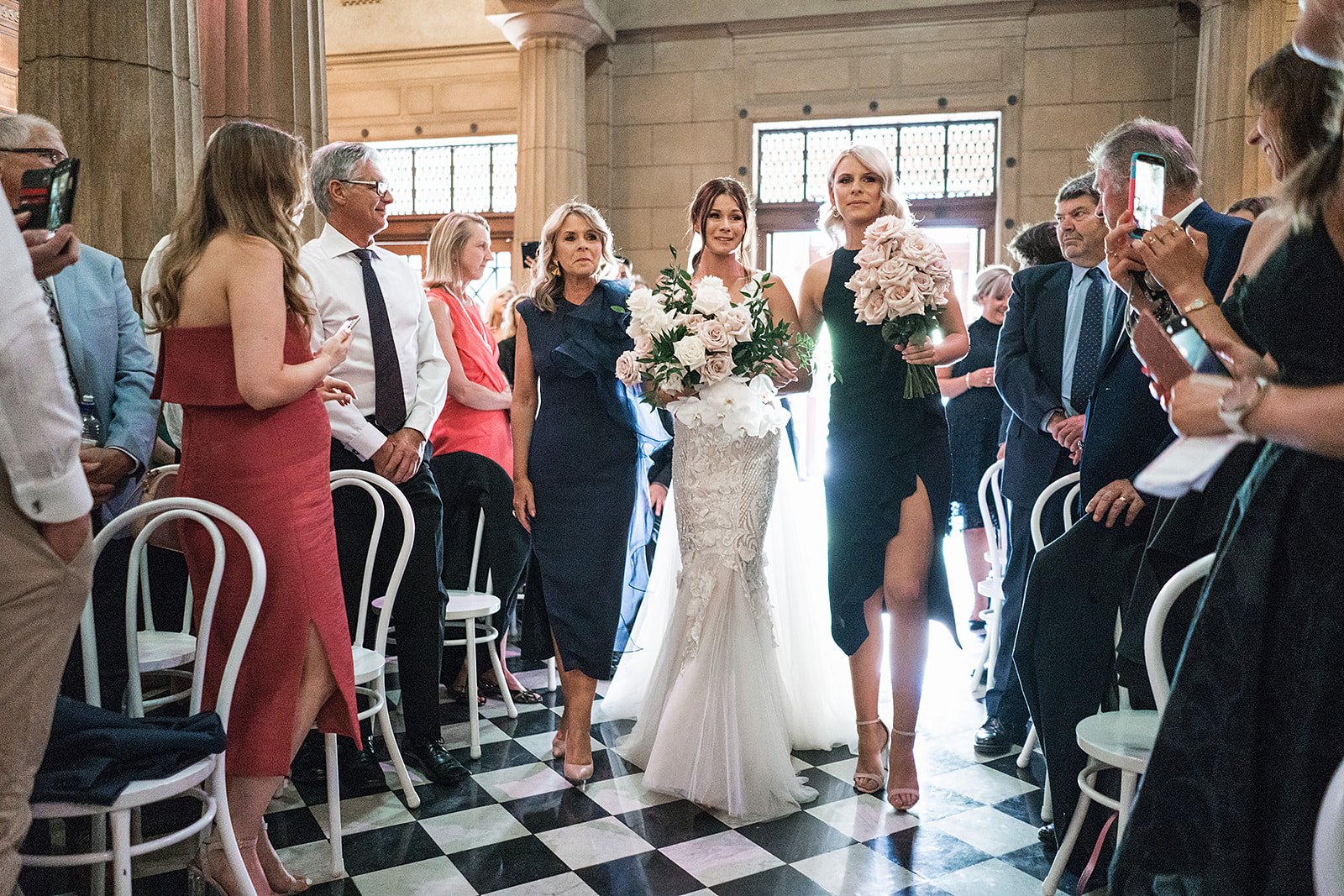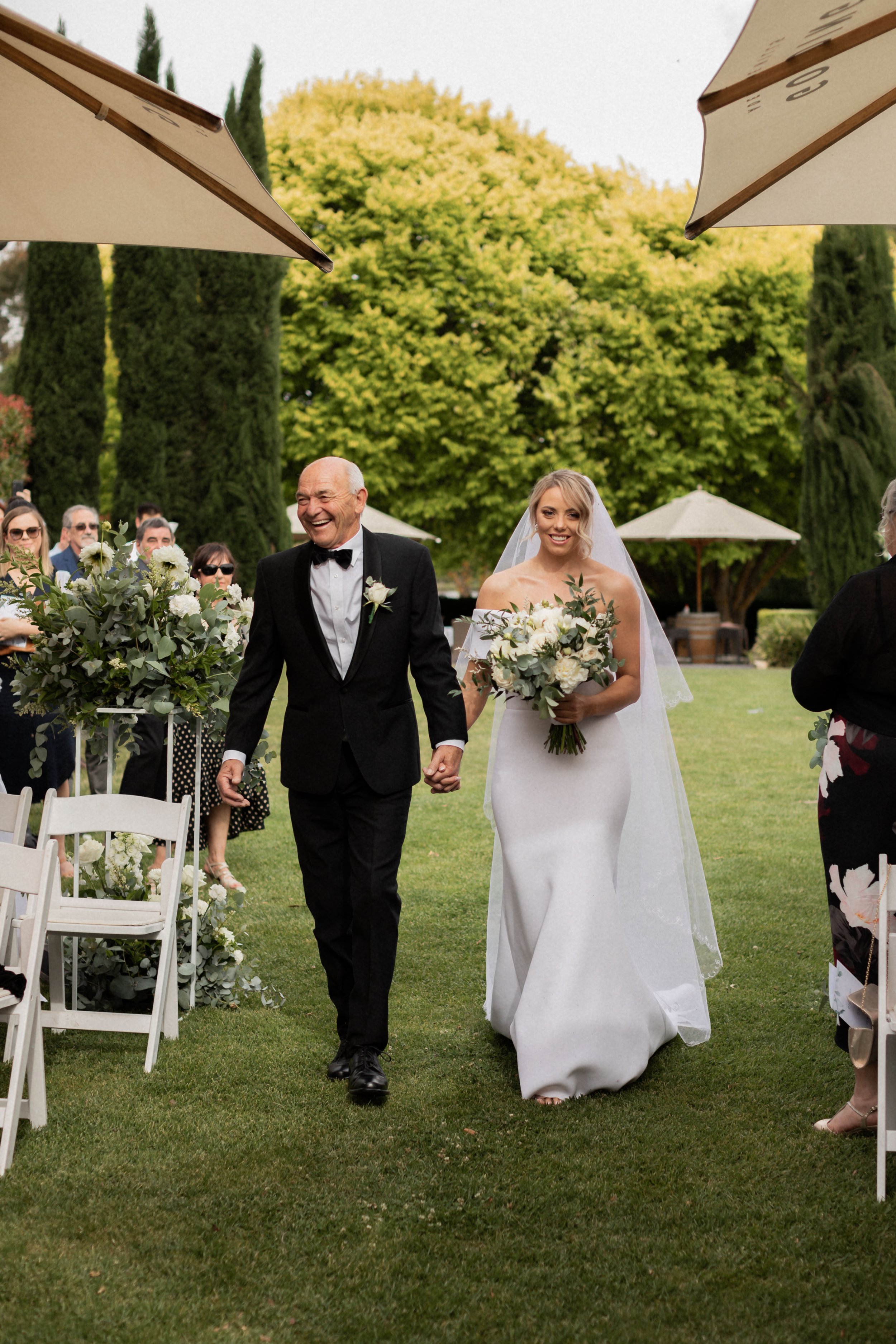Planning your wedding processional can be exciting, romantic, confronting, stressful, and challenging for a whole heap of deep and ingrained personal reasons.
Sure, you’re just walking down the aisle, but it’s what it signifies which can sometimes trip people up, so to speak!
Your wedding processional is the coordination of people and music which is commonly used to organise your (and your wedding party’s, if you’re having one) movement into the wedding ceremony venue or space.
While tradition and custom have played large roles in dictating what a couple does and who’s been involved in the past, many modern couples are now questioning common expectations and creating their own ways of arriving and starting their wedding ceremonies.
If you've been wondering what a wedding processional is all about, why there has to be a wedding processional, and how it works in different settings, we’ve got you covered.
Here’s everything you need to know, including who walks down the aisle first in a gay wedding.
Let's dive right in!
What is a Wedding Processional?
A wedding processional is how a group of individuals enter a ceremony space to begin a wedding ceremony.
The parties walk down the aisle (commonly a direct path that divides the seated or standing wedding guests, who are invited as witnesses) in a particular order before the commencement of the wedding ceremony, while (usually) a processional wedding song/s is playing.
This practice varies between traditions and religions.
Who Walks Down the Aisle?
The flower girls, ring bearers, bridesmaids, groomsmen, or wedding party, the couple-to-be, and sometimes their parents, are often part of this procession.
In a Jewish wedding, the grandparents of the couple also walk down the aisle.
Catholic and Hindu weddings have strict processional rules, however, in non-denominational weddings, the processional guidelines tend to be a little more relaxed.
How Does a Wedding Processional Work?
Though the order varies between civil ceremonies and religious weddings (and even between religions), this is the order for the processional of a traditional wedding ceremony.
Officiating Minister - The officiating minister leads the procession to signify that the wedding ceremony is about to begin.
Grandparents - The couple's grandparents are usually the next in line.
Parents - Since there are two sets of parents, they join the line depending on whether they sit on the church's left or right side. However, the bride's mother may join the procession separately with someone ushering her.
Groom - The groom can choose to walk alone or with his groomsmen.
Bridesmaids and Groomsmen - After other groomsmen and bridesmaids have paired up to join the processional, the best man and Chief Bridesmaid/Maid of Honour/Matron of Honour will be at the end of the line.
Ring Bearer - The person who has the ring/s walks in next.
Florist - The flower girl/s go just prior to the bride-to-be, throwing flower petals to give the bride a glorious entrance.
Bride - As the celebrity of the day, the bride walks majestically down the aisle with her father, who will hand her over to the groom, while the wedding processional music is playing in the background.
This is all assuming, of course, that you’re:
In a church and,
Are a hetero couple getting married, and,
You even want to enter your wedding ceremony via a processional in the first place.
In many modern civil ceremonies, the processional can take the form of anything from a whistle to the assembled guests to signal that the formalities are about to get underway to a full-blown choreographed entrance and flash mob.
Brides, grooms, couples and kids arrive together, or on their own, with elegance and grace, or sometimes, fanfare and a helicopter arrival.
The sky is literally the limit!
Videos courtesy of Lifesketch Weddings
Variations on a Wedding Processional
The wedding processional is one of the most memorable and emotional aspects of a wedding ceremony and generally sets the tone for everything that follows.
The choice of music, special garments, order of processional and choreography all help to create the symbolism of the transition from single to married life. There are several variations in the order of the processional which include;
Christian Wedding Processional
Jewish Wedding Processional, and
Traditional Wedding Processional
Christian Wedding Processional
Below is the order of procession:
Grandparents of the couple
Parents of the Groom
Mother of the bride
Officiating pastor
Groom, escorted by his best man
Groomsmen and bridesmaids
Chief bridesmaid
Ring bearer
Flower and balloon girls
Bride, ushered by her father
Jewish Wedding Processional
Below is the order of procession:
Rabbi
Grandparents of the couple
Groomsmen, including the best man
Groom, ushered by his parents
Bridesmaids, including the maid of honor
Flower girl
Ring bearer
Bride, ushered by her parents
Traditional Wedding Processional
The order of procession is:
Grandparents of the intending couple
Parents of the groom
Mother of the bride
Marriage celebrant and the groom
Groomsmen and bridesmaids
Best man and chief bridesmaid
Ring bearer and flower girl
Bride, ushered by her father
Who Walks Me Down the Aisle?
At this point, you may be wondering who walks or escorts you down the aisle and in what order your processional should run. The good news is that you don’t have to embark on a long and exhaustive search to find the perfect or right person to walk you down the aisle.
While it’s still somewhat common for a father to escort his daughter and hand her over to her future husband, this is no longer such a strict expectation or necessity.
Sometimes, when appropriate, the bride's uncle, brother, nephew, or son could walk her down the aisle.
Alternatively, you can ask a female friend or relative to escort you to your wedding ceremony - most people feel honoured and humbled to be included in this way.
There are modern weddings that commence with both partners to the marriage entering into the ceremony space together, at the same time, to symbolise their equality and strength as a new family unit.
I’ve also witnessed entire immediate families escorting their loved ones down the aisle to signify their approval, sense of community and bond.
When there is a father and stepfather in the picture, clear and early communication is key.
What feels right and comfortable for you? In many circumstances, talking through your decision with the parties involved can make a decision easier and less prone to misinterpretation.
Your wedding entrance song
Of course, once you’ve worked out how you’re walking down the aisle and who (if anyone) you’ll have escorting you, the next question is “what song will I have for my entrance?”
The wedding processional entrance song (or songs if you choose to keep your wedding party and your entrance separate or have a large bridal party) the style, instrumentalisation or lyrics, genre, tempo and artist is another indicator of the atmosphere or theme you are trying to create. And most certainly the topic for another post.
We have some timeless suggestions from Amicus Strings HERE.
Bridesmaids’ song to walk down the aisle
When there’s a large number in the wedding party, or the processional walk is quite a distance, it might be necessary to choose a separate and additional song for the bridesmaid’s arrival before the bride’s.
The person responsible for coordinating the wedding party and the ceremony music may benefit from having a quick rehearsal before the wedding day to be sure that the timing between the bridesmaids works with the length of the song.
Who Walks Down the Aisle in a Gay Wedding?
In a heterosexual wedding, a bride will typically walk down the aisle last. In a gay wedding, this is not always the case. Who walks down the aisle in a gay wedding depends on the couple and their personal preferences, expectations, how they identify, their relationship dynamics and needs.
The space, dimensions and setup of your wedding ceremony venue can also affect your decision on how you want your processional to go. While some spaces (particularly long, narrow indoor rooms) only have the option for one aisle, others can accommodate two aisles for both of you to be able to both make your way to the designated spot to commence their ceremony. This can occur simultaneously, or one after the other.
In some cases, both partners will walk down a single aisle together and arrive at their ceremony hand in hand. In some ceremonies, the engaged couple will both walk in individually escorted by their parents or grandparents and/or proceeded by their wedding party.
The bottom line is, whatever makes you feel most honoured and comfortable in that moment is what you should be doing. Deep dive and ask yourself what that looks like for you, share your vision, practice it (so it makes sense IRL) and own it.
It can also help if your celebrant or officiant announces what’s going to happen with the processional to your guests before the ceremony commences - they love you and they want to support you!
Final Thought
If you’re concerned about how to go about your wedding processional without breaking any rules, you can always discuss your thoughts with your celebrant or officiant. They should be able to guide and give you plenty of options so you feel more at ease.
Chatting through your feelings with your family well before the big day can also ensure that any potential hurt feelings have plenty of time to be resolved.
And, whether you choose to walk down the aisle alone, with your fiancé or escorted by someone, will not affect the success of your wedding ceremony. Once you’re joined by your fiancé and your ceremony is underway, you won’t even remember how you got there anyway.









